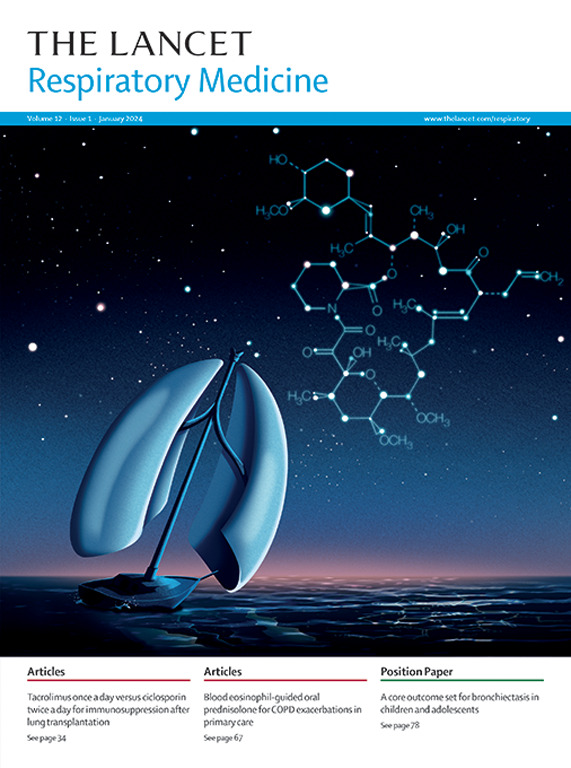在 SARP III 和 U-BIOPRED 中开发哮喘医疗负担评分,作为严重程度的衡量标准和缓解的预测指标:两大哮喘纵向队列的结果
IF 38.7
1区 医学
Q1 CRITICAL CARE MEDICINE
引用次数: 0
摘要
背景目前的哮喘指南,包括欧洲呼吸学会(ERS)和美国胸科学会(ATS)的指南,对哮喘缓解、疾病严重程度和医疗保健利用率的预测不够理想。我们旨在建立一种基于哮喘医疗负担数据评估哮喘严重程度的新方法。方法我们分析了从严重哮喘研究计划 III(SARP III,美国)和欧洲呼吸系统疾病结果预测无偏生物标记物(U-BIOPRED,欧洲 11 个国家)中收集的前瞻性数据,计算出了基于哮喘恶化和医疗保健利用率的综合负担评分,并对其进行了修改,将短效β受体激动剂(SABAs)的使用纳入其中,以反映哮喘症状负担。研究结果在 SARP III 中,对 528 名患有哮喘的成年参与者进行了平均 4-4 年(SD 1-6 年)的随访,根据 ERS-ATS 的定义,其中 312 人(59%)患有重度哮喘。在 205 名每天使用 SABAs 的哮喘患者中,有 90 人每天使用两次或两次以上。U-BIOPRED 对 509 名患有哮喘的成年参与者进行了为期一年的随访,其中 421 人(83%)患有重度哮喘。在 312 名 SARP III 参与者中,有 106 人(34%)的负担得分低于 1-29 分/人-年,在 421 名 U-BIOPRED 参与者中,有 80 人(19%)患有重度哮喘。相比之下,在 58 名(28%)SARP III 参与者和 24 名(27%)U-BIOPRED 参与者中,非重度哮喘患者的负担评分高于中值。在这两个组群中,负担评分与肺功能、哮喘控制和生活质量呈负相关。负担评分为 0-15 分或更低时,预测哮喘缓解的灵敏度大于 91%,特异度为 99%。解释:我们的研究结果凸显了目前哮喘严重程度的定义与我们的负担评分之间存在相当大的差异。虽然 ERS-ATS 和全球哮喘倡议(GINA)提出的重症哮喘定义是基于哮喘处方药,但我们的个性化医疗负担评分包含以患者为中心的数据,能反映疾病的严重程度并准确预测哮喘缓解情况。经前瞻性验证,该负担评分有助于优化哮喘高危人群的管理。资助SARP III:美国国家心肺血液研究所、阿斯利康、勃林格殷格翰、基因泰克、葛兰素史克、赛诺菲Genzyme/Regeneron和梯瓦制药。U-BIOPRED:创新药物倡议联合企业(欧盟第七框架计划和欧洲制药工业和协会联合会)和 eTRIKS 项目。本文章由计算机程序翻译,如有差异,请以英文原文为准。
Development of an asthma health-care burden score as a measure of severity and predictor of remission in SARP III and U-BIOPRED: results from two major longitudinal asthma cohorts
Background
Current asthma guidelines, including those of the European Respiratory Society (ERS) and American Thoracic Society (ATS), suboptimally predict asthma remission, disease severity, and health-care utilisation. We aimed to establish a novel approach to assess asthma severity based on asthma health-care burden data.Methods
We analysed prospectively collected data from the Severe Asthma Research Program III (SARP III; USA) and the European Unbiased Biomarkers for the Prediction of Respiratory Disease Outcomes (U-BIOPRED; 11 European countries) to calculate a composite burden score based on asthma exacerbations and health-care utilisation, which was modified to include the use of short-acting beta agonists (SABAs) to reflect asthma symptom burden.Findings
In SARP III, 528 adult participants with asthma were followed up for a mean of 4·4 (SD 1·6) years, and 312 (59%) had severe asthma according to the ERS-ATS definition. Among the 205 participants with asthma who used rescue SABAs daily, 90 used these two or more times a day. In U-BIOPRED, 509 adult participants with asthma were followed up for 1 year, and 421 (83%) had severe asthma. The burden score was less than 1·29 per patient-year in 106 (34%) of 312 SARP III participants and in 80 (19%) of 421 U-BIOPRED participants with severe asthma. By contrast, the burden score was above the median value in 58 (28%) SARP III and 24 (27%) U-BIOPRED participants with non-severe asthma. In both cohorts, the burden score negatively correlated with lung function, asthma control, and quality of life. A burden score of 0·15 or lower predicted asthma remission with a sensitivity greater than 91% and a specificity of 99%.Interpretation
Our findings highlight considerable discrepancies between the current definition of asthma severity and our burden score. Although the definition of severe asthma proposed by the ERS-ATS and the and Global Initiative for Asthma (GINA) is based on prescribed asthma medications, our personalised health-care burden score includes patient-centred data that reflect disease severity and accurately predicts asthma remission. Subject to prospective validation, the burden score could help to optimise the management of high-risk individuals with asthma.Funding
SARP III: US National Heart, Lung, and Blood Institute; AstraZeneca; Boehringer Ingelheim; Genentech; GlaxoSmithKline; Sanofi Genzyme/Regeneron; and Teva Pharmaceuticals. U-BIOPRED: Innovative Medicines Initiative Joint Undertaking (EU's Seventh Framework Programme and European Federation of Pharmaceutical Industries and Associations) and eTRIKS project.求助全文
通过发布文献求助,成功后即可免费获取论文全文。
去求助
来源期刊

Lancet Respiratory Medicine
RESPIRATORY SYSTEM-RESPIRATORY SYSTEM
CiteScore
87.10
自引率
0.70%
发文量
572
期刊介绍:
The Lancet Respiratory Medicine is a renowned journal specializing in respiratory medicine and critical care. Our publication features original research that aims to advocate for change or shed light on clinical practices in the field. Additionally, we provide informative reviews on various topics related to respiratory medicine and critical care, ensuring a comprehensive coverage of the subject.
The journal covers a wide range of topics including but not limited to asthma, acute respiratory distress syndrome (ARDS), chronic obstructive pulmonary disease (COPD), tobacco control, intensive care medicine, lung cancer, cystic fibrosis, pneumonia, sarcoidosis, sepsis, mesothelioma, sleep medicine, thoracic and reconstructive surgery, tuberculosis, palliative medicine, influenza, pulmonary hypertension, pulmonary vascular disease, and respiratory infections. By encompassing such a broad spectrum of subjects, we strive to address the diverse needs and interests of our readership.
 求助内容:
求助内容: 应助结果提醒方式:
应助结果提醒方式:


